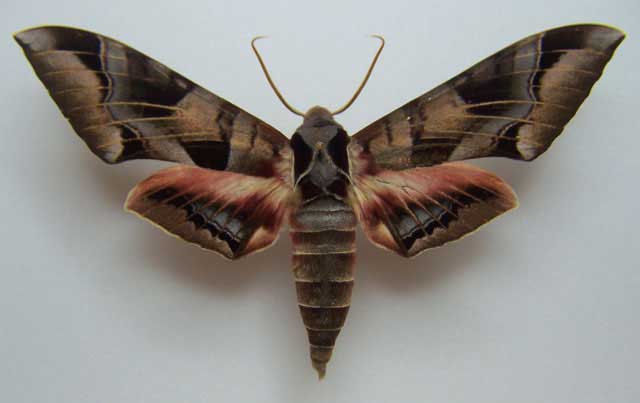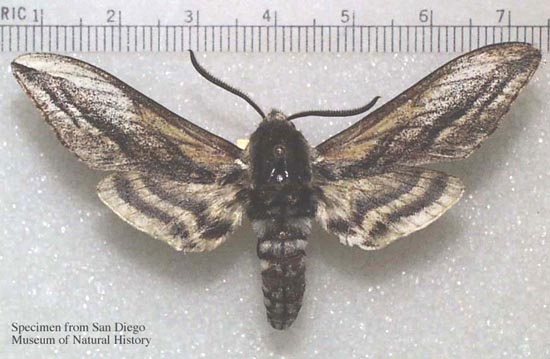Sphinginae subfamily
Sphingini tribe:
 | This species is a strong migrant and adults nectar from
deep-throated flowers including moonflower (Calonyction aculeatum),
morning glory (Convolvulus), honey suckle (Lonicera)
and petunia (Petunia species).
|
 |
Ceratomia amyntor
USGS,
the Elm Sphinx or Four-horned Sphinx
The upperside of the forewing is brown with dark brown and white markings including a white costal area near the wing base, dark streaks along the veins,
and a white spot in the cell.
Larvae feed on Elm (Ulmus), birch (Betula), basswood (Tilia), and
cherry (Prunus). |
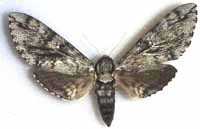 |
The fringes of the upper wings are checkered black and white. The
upperside of the forewing is dark gray with black
bars and dashes and whitish patches. The upperside of the hindwing is
dark brown with pale gray at the base and has
two black transverse lines.
|
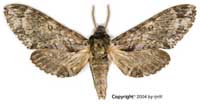 | This small moth flies at dusk. Both the forewing and the hindwing have a dark spot at the anal angle.
The forewing has a dark cell marking with a white center. There is also a dark patch along the inner margin in the basal area.
|
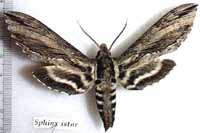 | The upperside of the forewing is dark gray with brown tinges. A
series of narrow dashes runs from the tip to the
cell spots, and a wide black band runs from the middle of the
outer margin to the base of the wing.
|
Linternia istar - 1, Copper Canyon, Huachuca Mountains, 24 July 2010, courtesy of Evan Rand
Linternia istar - 1, Long Park, Chiricahua Mountains, 3 July 2010, elevation 9300', courtesy of Evan Rand
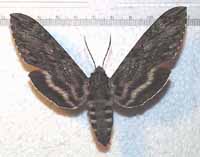 | The upperside of the forewing is dark gray with black and light gray
wavy lines. The upperside of the hindwing is black with a brownish
gray border and two white bands.
|
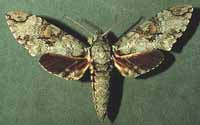 |
The upperside of the forewing is gray to yellowish gray to brown.
The reddish brown patch
just outside the cell and above the dashes is the most distinguishing
character.
|
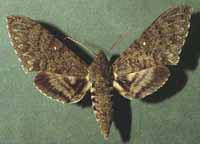 |
The upperside of the moth is soft greenish gray; the forewing has a
small green to white cell spot, and the hindwing has black bands
and a black patch at the base.
|
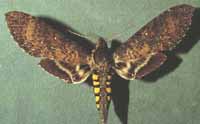 | Manduca occulta can be differentiated from M. sexta
which has 2/3 black, 1/3 white checkering on the
forewing, while occulta has equal amounts of black and white
checkering.
|
 |
This species is confirmed in Yavapai County, and
has been seen in nearby counties.
I suspect if you grow tomatoes, you are likely to encounter it.
|
 |
This species is officially recorded in Yavapai County, and it has been
taken in other nearby counties. Look for three large yellow spots
on each side of the abdomen.
|
 |
This species is recorded in Yavapai County.
If you grow tomatoes, you have probably encountered it, though.
Larvae get very large and can strip a tomato plant.
|
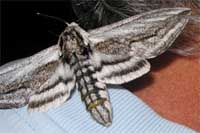 |
Sagenosoma elsa
USGS, the Elsa sphinx:
Forewing upperside has a wide white band along the costa from base to apex. The remainder of the wing has black and white bands.
The entire forewing is speckled with dark dots and has a light dusting of pale yellow to yellow-green scales.
The upperside of the hindwing is white with two black bands.
|
Sagenosoma elsa - 1, Kansas Settlement Road at Willcox Playa, 27 July 2010, Evan Rand
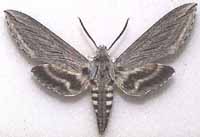 |
The upperside of the forewing is pale silver-gray with a series of
black dashes, a white patch at the tip, and a white stripe along the
outer margin. The upperside of the hindwing is black with blurry
white bands.
|
 |
Sphinx chersis
USGS,
the Northern Ash Sphinx or Great Ash Sphinx
This species is reported in Yavapai. Larval hosts are ash,
lilac, privet, cherry, and quaking aspen.
|
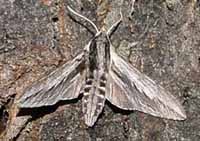 | Sphinx dollii (Wing span: 1 3/4 - 2 1/2 inches (4.5 - 6.3 cm)),
flies in arid brushlands and desert foothills from Nevada and
southern California east through Utah,
Arizona, Colorado, and New Mexico to Oklahoma and Texas.
|
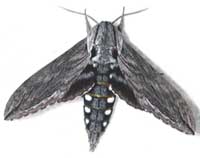 | The upperside of the forewing is pale blue-gray to dark gray with a black dash reaching the wing tip and
a white stripe along the lower outer margin.
The upperside of the hindwing is black with two diffuse white
bands, the upper one being practically non-existent.
|
Smerinthini Tribe:
 |
This one is quite similar to Pachysphinx modesta, with modesta
being smaller and darker.
Moths should be on the wing from June-August.
|
 |
Paonias myops
USGS, the Small-eyed Sphinx
Named for the small eye-spot in the hindwing, this moth has a wide
distribution.
|
 |
Smerinthus cerisyi
USGS, the Cerisyi's
Sphinx or One-eyed Sphinx, Larvae feed on poplars and willows.
Flight would be from late May-July as a single brood.
|
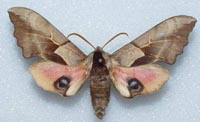 |
Smerinthus saliceti
USGS, the Salicet
Sphinx, flies in valleys and along streamsides from Mexico City north
to west Texas, southern Arizona, and extreme southern California.
Larvae feed on poplars and willows.
Flight would be from late April-September, probably as a double brood.
|
Macroglossinae subfamily
Dilophonotini tribe:
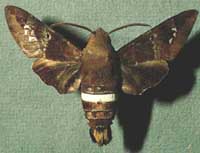 |
The body is dark brown with a wide white
band across the abdomen. Wings are dark brown. The forewing has a
black cell spot and 3 white spots near the pale brown marginal
area. possible stray |
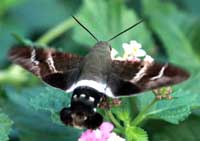 |
The body is dark brown with a wide white stripe across the abdomen.
The wings are dark brown. It is very similar to above species, but the
upperside of the hindwing has
pale patches along the costa and inner margin. possible stray
|
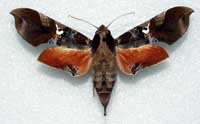 |
This species is redder than C. parce, has more falcate wings and flies after midnight. The very similar
Callionima parce is browner, slightly less falcate and flies before midnight.
possible stray
|
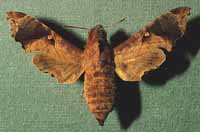
|
The body and wings are dark brown. The forewing has a large black
patch covering most of the outer half of the wing. There is a pale
tan cell spot (dark inner pupil), and a fairly straight median line
to the inside of the cell spot. possible stray
|
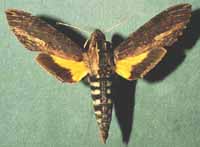
|
The upperside of the forewing is dark brown with short yellowish
streaks on the forward half and wavy yellowish bands on the rear
half.
The upperside of the hindwing is bright yellow with a wide
dark brown border. possible stray
|
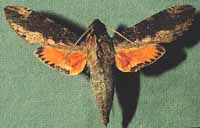 |
The upperside of the abdomen is gray, without black bands, and
the underside does not have black spots. The upperside of the
forewing is dark brown, and may have pale yellow-brown patches
along the inner edge.
|
 |
Erinnyis ello USGS, the Ello Sphinx:
Abdomen has very distinct gray and black bands. Female's fw upperside is pale gray with a few dark dots near outer margin. Male's fw upperside is
dark gray and brown with a black band running from base to tip. Hindwing upperside is orange with wide black border.
|
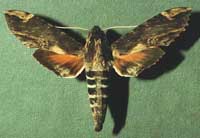 |
The upperside of the forewing is dark brown with gray streaks along the inner margin and a gray patch at the tip of the wing.
The upperside of the hindwing is dark brown with varying amounts of dark orange at the base.
possible stray
|
 |
During the night adults nectar at flowers, including bouncing bet
(Saponaria officinalis) and Asystasia gangetica beginning at dusk.
July and August are flight times in the southern states.
|
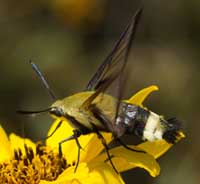 |
Hemaris thetis WO, the Thetis Clearwing or Bee Hawk Moth,
The moth flies along forest edges and in meadows, gardens and
brushy fields. Day-flying adults nectar at lantana, dwarf bush honeysuckle,
snowberry, orange hawkweed, thistles, lilac, Canada violet, etc.
|
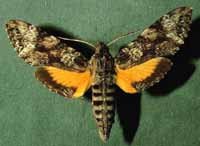 |
Isognathus rimosa, the Rimosus Sphinx,
USGS
The upperside of female forewing is mostly gray brown on the front
half and dark brown on the rear half while the upperside of male
forewing is yellow gray or gray brown. Both sexes have wavy dark
markings. The upperside of the hindwing of both sexes is yellow with
an incomplete dark border on the outer margin. stray
|
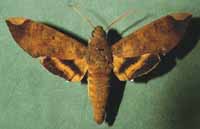 |
Pachylia ficus, the Fig Sphinx,
USGS.
The upperside of the forewing is orangish brown
with a paler patch along the costa at the tip. The upperside of
the hindwing is orange to orangish brown with a black outer border, a
black median band, and a white spot on the outer margin near the body. stray
|
Philampelini tribe:
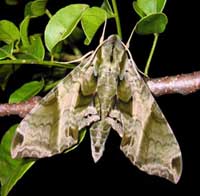 |
Bruce Walsh reports a sighting on August 26, 2010, at MS lights, along the Foothills Road, just north of Portal
(on the plains just east of the Chirichahua Mts.), Cochise County, Arizona. Id has been confirmed by Ian Kitching.
This is probably a wind assisted stray form much further south.
|
 |
Eumorpha fasciatus
USGS, the Banded Sphinx/Lesser Vine Sphinx.
The upperside of the moth is dark pinkish brown. Each forewing has a
lighter brown band along the costa, and sharp pinkish white bands and
streaks. Larvae feed upon primrose-willow, Ludwigia (water primrose)
and other plants in the evening primrose family. possible stray
|
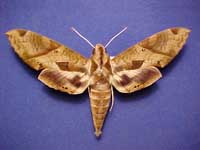 |
The Satellite Sphinx Moth, Eumorpha
satellitia licaon flies in western Mexico and sometimes strays into southeastern
Arizona. stray
|
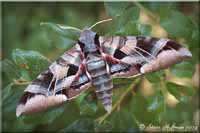 |
The upperside of wings is deep red-brown with pale brown bands. Each
hindwing has pink along the costal margin and a triangular white spot
on the outer part of the inner margin.
|
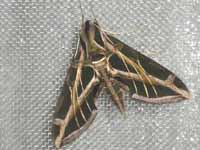 |
The upperside of the moth is dark pinkish brown. Each forewing has a
lighter brown band along the costa, and sharp pinkish white bands and
streaks. The hindwing has a pink patch on the inner margin.
possible stray
|
Macroglossini tribe:
 |
Hyles lineata
USGS,
the White-lined Sphinx The white lines on the body and forewings are striking.
Even in flight, the broad pink area on the hindwings is visible.
Larvae can be quite varied.
|
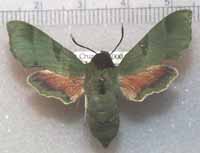 |
The upperside of the forewing is uniform olive green with a darker
median band. The upperside of the hindwing
is red with an olive green border.
|
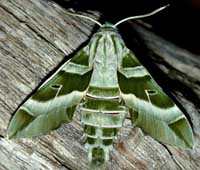 |
Jim Tuttle writes, "P. vega has a very large and dark basal
patch as the FW meets the thorax that is lacking in terlooii.
There are also three prominent longitudinal
stripes on the thorax of vega that are lacking in
terlooii." possibility
|
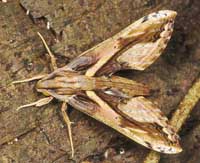 |
The upperside of the forewing is yellowish brown with dark brown markings in the basal area, and diagonally from near
the apex to the center of the inner margin. There is a small dark cell spot. The outer margin is distinct, set off
from the rest of the wing by a pale subterminal line.
unlikely stray
|
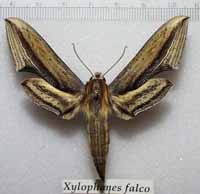
|
The upperside of the forewing is orange-brown along the forward half, striped with dark brown and light brown along
the rear half, with dark brown bands separating the two. The
upperside of the hindwing is pale brown with dark brown
marginal and submarginal lines.
|
 |
The upperside of the forewing is pale brown with lavender-gray at the base and has dark brown lengthwise lines throughout.
The upperside of the hindwing is dark brown with a band of whitish, wedge-shaped marks.
possible stray
|
|
|
